China wants growth to Go West
Shanghai and Beijing are booming, and the prime real estate has been snapped up along the East Coast. But opportunities abound for pioneers in China who do as Horace Greeley long ago suggested in another frontier land: "Go West."
By Ron Gluckman/Chongqing, Beijing and Shanghai
IN SPITE OF A RECENT SLOWDOWN in some real estate market sectors in China’s biggest cities, opportunities remain for pioneers.
They should
look beyond the gateway cities, where double-digit growth has been the norm for
a decade, and even beyond the secondary cities along the east coast from Qingdao
to Xiamen that are already well along in their development.
As was the case in America during the 19th
century, the key is to go west. In China, this means inland, to provincial
centers that have yet to experience the development common in many parts of the
country.
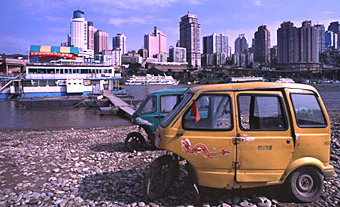 Perhaps no
place better epitomizes the pioneer spirit---or the enormous possibilities that
still remain in China---than Chongqing, the vast central
Chinese city that is, by many measures, the largest not only in the Middle
Kingdom, but the world.
Perhaps no
place better epitomizes the pioneer spirit---or the enormous possibilities that
still remain in China---than Chongqing, the vast central
Chinese city that is, by many measures, the largest not only in the Middle
Kingdom, but the world.
China has only four
municipalities; Beijing, Tianjin and Shanghai are the others. These
special metropolitan areas share an
unparalleled level of autonomy, reporting to the federal government rather than
to provincial governors. Chongqing, the largest in land area
and population, claims 33 million people in a sprawling municipality the
size of Belgium.
“Chongqing is an up-and-coming city,” advises
Sam Crispin, head of Crispin Property Consultants in Shanghai, where he has been
providing real estate and other business services for more than a decade.
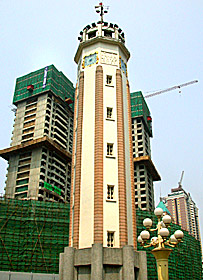 Crispin’s prognosis for the city of more than 31
million is buoyed by the flow of major government spending there. Beijing has
been showering Chongqing with more than $2 billion annually for
infrastructure---a generous infusion it has committed to continue for a decade.
Crispin’s prognosis for the city of more than 31
million is buoyed by the flow of major government spending there. Beijing has
been showering Chongqing with more than $2 billion annually for
infrastructure---a generous infusion it has committed to continue for a decade.
This funding is paying for a matrix of new highways and rail lines converging in Chongqing, already the port-head of an enlarged Yangtze River navigable 1,000 miles to Shanghai and the coast because of construction of the Three Gorges Dam.
Beijing wants to transform Chongqing into a central city that it plays the same role for China that Chicago has long served in the United States, becoming an inland hub serving a hinterland of 325 million people.
This ambitious aim is part of a larger plan to divert
capital and development inland to China’s poorest regions in what is called the
“Go West Campaign.”
“Opportunities are outstanding,” says Sunshine
Dong, founder and managing director of Prospect International Company, a
Chongqing consultancy that held the International Real Estate Fund Chongqing
Summit last November (2005).
“The cost of land here is very low, and so are labor costs. Margins are good.” Dong, who comes from Hebei province, says Chongqing offers lucrative incentives, including tax waivers.
“Big cities in China have fewer possibilities these days,” he says. Meanwhile, Chongqing is developing at a pace unlike any other modern metropolis except Shanghai.
 “Chongqing is just like Shanghai, only ten years behind,” notes
deputy mayor
Huang Qifan, someone who should know. Huang was largely responsible for guiding
Shanghai’s rapid development in the 1990s, and was shifted to Chongqing by
Beijing largely to replicate that success.
“Chongqing is just like Shanghai, only ten years behind,” notes
deputy mayor
Huang Qifan, someone who should know. Huang was largely responsible for guiding
Shanghai’s rapid development in the 1990s, and was shifted to Chongqing by
Beijing largely to replicate that success.
“Foreign investment is about the same as Shanghai a decade ago,” he says, running off statistics pointing out the similarity of the two cities, ranging from the number of five-star hotels to apartment sizes.
Certainly, Chongqing gives the impression of being a city on the rise, with scores of new shopping malls, attractive plazas dotting a downtown pedestrian mall, and fountains along a riverside district of bars and restaurants.
Yet, aside from a downtown tower with a striking resemblance to the Chrysler Building (its Chinese name means New York, New York), the city has yet to make a great leap forward to become a true cosmopolitan center.
Unlike other inland centers, Chongqing has never been a historic capital. Its
main fame came during World War II, when the national government retrenched in
the city after the Japanese invasion. Much wartime industry followed,
contributing greatly to intense local pollution.
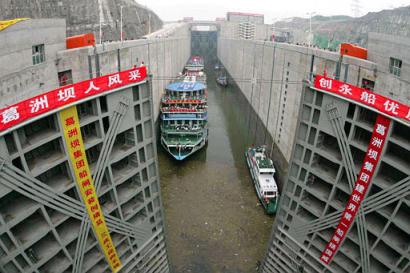 Even a decade ago, Chongqing had little international recognition except as the
smog-bound starting point for cruises on Three Gorges River. Concerted cleanup
campaigns have moved much industry upstream, closing some of the most polluting
factories.
Even a decade ago, Chongqing had little international recognition except as the
smog-bound starting point for cruises on Three Gorges River. Concerted cleanup
campaigns have moved much industry upstream, closing some of the most polluting
factories.
Trading on its manufacturing experience, Chongqing has become a major
producer of motorbikes and machinery; Ford Motor Company
operates a big
automobile production facility in the city.
Known to most Chinese as one of the
infamous “furnace cities,” Chongqing
swelters in the summer, when the ring of surrounding hills and persistent mist
send temperatures soaring.
With a huge rural population, Chongqing is also
famous for its hog farms and factories. Average wages, at $2 to $3 per day, are
much lower than those in Beijing or Shanghai, according to government
statistics.
One of the key attractions of Chongqing is its relative affordability, with
development costs about one-third of those in Shanghai, according to Michael
Hart, head of research, Greater China, for Jones Lang LaSalle in Shanghai.
Government spending has not only made the city more attractive to developers, he
says, but also has raised its profile dramatically. “Chongqing has certainly
been going all out on development,” he says. “People I met with a few years ago
had no idea where it was, but now, everyone has heard of Chongqing.”
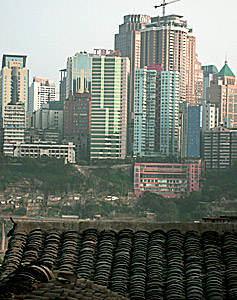 To date, most real estate investment has flowed from Hong Kong, Taiwan, and
Singapore. One of the first and biggest movers was Hutchinson Whampoa, the Hong
Kong property powerhouse, which in 1997 completed Metropolitan Plaza, a leading
commercial center with a shopping mall, an office tower, and a five-star hotel,
and more recently completed Beverly Hills, a luxury villa development.
To date, most real estate investment has flowed from Hong Kong, Taiwan, and
Singapore. One of the first and biggest movers was Hutchinson Whampoa, the Hong
Kong property powerhouse, which in 1997 completed Metropolitan Plaza, a leading
commercial center with a shopping mall, an office tower, and a five-star hotel,
and more recently completed Beverly Hills, a luxury villa development.
Singapore’s CapitaLand, active in mainland development using cash from the sale
last year of its stake in the Raffles chain and other hotel holdings, built a
mall in which a Wal-Mart opened last June (2005).
Also last summer, Hongkong Land
unveiled plans for Bamboo Grove, a 4.8 million-square-foot site with developable
area of 10.8 million square feet. This marks the Hong Kong firm’s entry into the
local market in partnership with Chongqing Longhu, the top local developer with
more than 16 million square feet of property completed since its formation in
1995, including Fragrant Garden Villa Longhu Garden, Blue County, Nanyuan Longhu
Garden, and Crystal Town Longhu Garden.
The biggest project on the horizon by far is Chongqing Tiandi, a $1.2 billion,
14 million-square-foot mixed-use development. With 1.2 miles of riverfront, the
massive project will include business facilities, hotels, and office buildings,
as well as residential clusters that add dining, shopping, and entertainment
amenities.
The project is being mounted by Hong Kong’s
Shui On Group, something
of a blue-chip mainland developer with successful similar projects in Shanghai
and Hangzhou.
“I sense considerable opportunity in Chongqing,” says
Vincent Lo, Shui On Group
founder and CEO, who has became one of Chongqing’s biggest boosters. “I feel
very positive about Chongqing---even more positive over the past two or three
years as I see what they are doing and what they plan to do.”
To critics who point out the scarcity of big-name foreign investors in Chongqing,
Lo concedes ambitious local plans have not yielded visible results---yet.
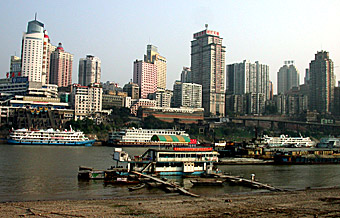 “Looking on the surface, you might not see much of a boom, but the economics
speak for themselves,” he maintains. Lo points out that though foreign direct
investment was dropping across China last year, it increased by 25 percent in Chongqing in the first nine months.
“Looking on the surface, you might not see much of a boom, but the economics
speak for themselves,” he maintains. Lo points out that though foreign direct
investment was dropping across China last year, it increased by 25 percent in Chongqing in the first nine months.
“That’s a definite sign that people are
noticing Chongqing and putting money into Chongqing,” he says. “Chongqing’s
development is still in the early stages. A lot of companies have acquired land,
but they just haven’t built yet---like us. So you don’t see development
happening, but it is happening very fast.”
Still, Lo discounts the overly enthusiastic comparisons of Chongqing to
Shanghai. “Chongqing is very different from Shanghai,” he notes. “They have
different backgrounds, and are very different places. I don’t think Chongqing
will ever become like Shanghai.”
The latter, he adds, moved from manufacturing
to services, including finance, while Chongqing is still moving from low-cost
industries to more lucrative manufacturing. “Ultimately, I think it will more be
like Chicago than New York or Shanghai,” he says.
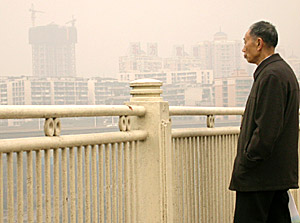 There are other differences, too, including an Old World mindset among officials
in Chongqing cited by many with experience doing deals in the city. “All
developers want to go where there is less competition,” notes Hart. “But then
they often find a lot less opaqueness.” In such places, he adds, “it’s tough to
compete with the local players.”
There are other differences, too, including an Old World mindset among officials
in Chongqing cited by many with experience doing deals in the city. “All
developers want to go where there is less competition,” notes Hart. “But then
they often find a lot less opaqueness.” In such places, he adds, “it’s tough to
compete with the local players.”
Some investment has bypassed Chongqing in favor of nearby Chengdu. “Chengdu has
natural advantages,” notes Douglas Webster, professor at the Arizona State
University School of Global Studies and adviser to various Chinese cities on
urban planning.
These advantages include better education services and income levels, he says. “And Chengdu is already the aviation hub for the area. That’s an advantage that will be difficult to overcome.”
With its international connections, Chengdu is the more sensible center of global investment, he maintains. But Chengdu’s main advantage, Webster notes, is that it is much more livable and more cosmopolitan than Chongqing.
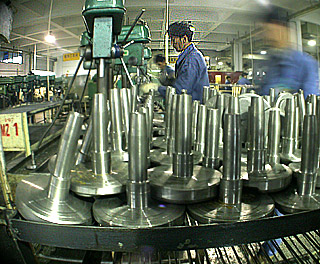 As the capital of Sichuan, China’s most
populous province (which formerly included Chongqing), Chengdu has been a
government and cultural center for more than 2,000 years. No amount of capital
investment can compensate for all that history and culture, he adds.
As the capital of Sichuan, China’s most
populous province (which formerly included Chongqing), Chengdu has been a
government and cultural center for more than 2,000 years. No amount of capital
investment can compensate for all that history and culture, he adds.
The upcoming five-year plan, the official road map for governance in China, is
expected to focus on the Chengdu-Chongqing corridor as the growth center for the
region.
The two cities are less than four hours apart by automobile, and the gap keeps narrowing as more infrastructure comes on line.
The two cities can complement each other as parts of a megalopolis serving not only hundreds of millions of people in the Chinese hinterland, but also central Asia, Webster predicts, and eventually could come to rival Bangkok as a regional capital.
Ron Gluckman is an American reporter who has been roaming around Asia since 1991, based in Hong Kong, Beijing and Bangkok. He has been visiting Chongqing since 1992. This story was published in Urban Land Institute's magazine in January 2006.
All pictures by Ron Gluckman
To return to the opening page and index
push here
[right.htm]
